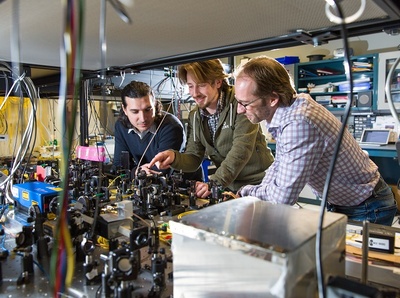Two groups both reported successfully teleporting state information across metro-scale fibre networks.
A Chinese team is claiming a teleportation over a 30 km fibre in Haifei (the entanglement travelled nearly 16 km), while the University of Calgary used that city’s fibre network to carry entanglement 6.2 km.
The ability to achieve quantum teleportation is an important benchmark for quantum-optical networks and the research suggests that telecommunication networks could be used for a range of quantum communications such as distributed quantum computing.
First proposed in the 1990s, quantum teleportation involves transporting a quantum state of a particle – the polarization of a photon, for example – across space without moving the particle itself. This involves making a special initial measurement on the particle, transmitting the measurement information to a receiving destination and then reconstructing a perfect copy of the original state. Crucially, the original particle loses all of the properties that are teleported. This satisfies the “no-cloning” theorem of quantum mechanics, which dictates that it is impossible to make a perfect copy of a quantum state.
Charlie in the middle
The recent demonstrations were done by two independent teams – one led by Jian-Wei Pan at the University of Science and Technology of China in Hefei and the other by Wolfgang Tittel at the University of Calgary. Both groups used set-ups that involved an agent called “Alice”, who possesses the quantum state of a photon to be teleported, and an agent called “Bob” who receives the information and recreates the quantum state. Much of the work is done by a third party called “Charlie”, who possesses most of the sophisticated optical equipment needed to achieve quantum teleportation. This is seen as a practical way of achieving quantum teleportation because it only requires Charlie to buy and maintain expensive and delicate equipment.
The use of three “agents” to exchange quantum information is not new. It was first implemented last year by Ronald Hanson and colleagues in the Netherlands, who used it to perform a “loophole-free” Bell-violation experiment. In that experiment, however, the maximum distance between Alice, Charlie and Bob was just 1.28 km. In contrast, the Hefei and Calgary experiments involve optical fibres longer than 10 km.
Bell measurement
The most difficult part of the teleportation exercises is the initial “Bell measurement”.
This is made by Alice on the photon to be cloned and also on one photon in a pair of entangled photons. The result of this measurement is then sent to Bob, who also receives the other photon in the entangled pair. Using Alice’s measurement information, Bob then makes a further measurement on the entangled photon, which puts it into the same quantum state as the cloned photon.
In the Hefei implementation, generating the entangled pair and making the Bell measurement are done by Charlie. In the Calgary experiment, Charlie does the Bell measurement but Bob creates the entangled pair. In both cases, Alice supplies the quantum state to be cloned and Bob makes the final measurement. In both experiments, photons travel in excess of 10 km along optical fibres.
Researchers in Calgary used a commercial fibre link for their experiment, but the fibre was “dark” with no traffic running through it. The Hefei fibre network is dedicated to quantum communication and has been specially constructed to minimize interference with quantum signals.
Agencies/Canadajournal
 Canada Journal – News of the World Articles and videos to bring you the biggest Canadian news stories from across the country every day
Canada Journal – News of the World Articles and videos to bring you the biggest Canadian news stories from across the country every day



